The ancestor of the Katana, the deeply-curved Tachi is recreated here by BattleBlades in lavish detail and embellishment fitting for a sword that is the ancestor of the Katana and a sword worn and borne into battle by distinguished elite Samurai cavalry; a sword that would be associated by warrior nobles and their closest personal retinues who were to stand apart in their arms from common Katana. BattleBlades has pulled out all the stops to do full justice to the ancient Tachi sword by matching a premium blade with sumptuous koshirae fittings of outstanding quality. The blade is crafted from forge-folded 1095 high carbon steel which was made into separate panels and components and melded together into a laminated blade in the Honsanmai style by a very skilled swordsmith.
Laminating was a traditional blade technique for katana that separated out the tamahagane blooms of steel from a crucible, using the softer steel for a flexing, shock-absorbing core and the harder steel for a steel “jacket” and edge. Then the blade would be clay-tempered to imbue it with a hamon of crystallized, hardened steel. This is a blade construction method that is as laborious as it is traditional and requires a smith of very high caliber. These methods were all used in the forging of this Tachi blade and a close look at the edge reveals not only the wave like hamon, but also a thin, sharp line of visible steel lamination. The blade was then painstakingly polished to a fine sheen and finish to bring out the full beauty of the wood-grain like folded steel and its accompanying hamon and lamination. The blade in itself is a showcase of the traditional swordsmithing arts of Japan.
The Koshirae fittings are likewise immaculate and crafted from beautifully antiqued copper with detail picked out in bright polished finish for contrast. The hardwood tsuka is fitted with black lacquered rayskin and carefully overlaid in golden silk ito wrap with two antiqued brass fish menuki fitted beneath the folds. The Tachi has a saya scabbard which features the characteristically high level of stylistic fittings of the Tachi, which were often far elevated over Katana. The well-carved saya has been black lacquered and fitted partially with black rayskin and a matching gold silk wrap. A sageo cord attached to a leather Ashi allow for the Kazari Tachi to be worn at the belt, or simply displayed as the centerpiece of a collection.
History of Tachi:
During the Heian period (794-1185), Japanese swordsmiths began to develop differently tempered and curved blades better for slicing, replacing the preceding blades designed for hacking and stabbing. This resulted in the creation of the first japanese sword with a curved blade, the tachi. Tachi is a traditional Japanese sword with sabre-like qualities, worn by the high-ranking samurai in the Kotō period (900-1596). It is known to be the predecessor of the developement of the katana, which were popularized almost 300 years later. In the Kotō period, the samurai working for the emperor were the only ones allowed to carry tachi and ride horses in battle, so even after the Muromachi period (1336–1573), when katanas became the mainstream sword, tachi was still often worn by high-ranking samurai, to pay homage to its history. For 700 years through the Kotō period, the samurai always paired their lengthy tachi with a shorter sword, an uchigatana or wakizashi. Due to the changes in fighting style during the Edo period (1603–1868), when guns, spears and bows became main weapons of warfare, the samurai started to replace their tachi of the daishō with a more lightweight katana.
Distinctive Look:
The tachi has a deeper degree of curvature and a slightly longer blade than a katana, which benefitted the feudal samurai fighting on horseback, as the curved blade adds significant downward force when cutting. The length of the nagasa varied throughout the periods, but was later officially fixed between 44 to 80 centimeters. An authentic tachi is heftier compared to a katana, but is generally lighter in proportion to its length, has a greater taper from hilt to point and a smaller point area for penetrating heavy clothing. Unlike a traditional katana, tachi is carried on the belt blade down for faster wielding and slashing. The carrying system on the saya consists of ashi (suspension loops), and obitori (cord) usually made of leather or silk. The obitori is used to attach the tachi to the obi (belt) and the tachio is wrapped around the waist to further stabilize the saya. The tsuka typically follows the curvature of the nagasa and is made of rayskin covered hardwood and is most often hinerimaki wrapped. Morozori tsuka was most commonly used in tachi swords, but here is no set shape of tsuka for a tachi, as it changed a lot troughout the different periods. Despite all the changes, the characteristic mountings on tsuka and saya, stayed in fashion. These mountings are called kabuto-gane (hilt cap), semegane (scabbard ring) and saya-jiri (scabbard tip).
BattleBlades Design
Every detail of the Kazari Tachi is carefully chosen to highlight tachi’s distinctive characteristics. The honsanmai laminated 1095 steel nagasa has a very deep koshi-zori curve, and is much wider than any of our previous swords’ nagasa. For example, compared to Zugaikotsu Honsanmai Shinken‘s blade, Kazari Tachi’s is almost one centimetre wider by the tsuba. Using the honsanmai lamination together with this blade geometry resulted one of the most beautiful and showy blades we have ever designed. The folded layers are very visible throughout the whole blade, giving it almost a wood grain looking finish The morozori shaped tsuka, which tapers towards the kabuto-gane, is shaped to be a continuation of the deep nagasa sori.
We took some inspiration from our Kogane series and implimented it in the materials. The hardwood tsuka is covered with black rayskin and wrapped in golden silk rope, using hinerimaki style to ensure maximum grip. The black and gold color scheme continues gracefully to the oval tsuba, embellished with a golden edge and a golden chrysanthemum-like flower pattern in the middle. The kabuto-gane, the sarute (ring hanging from kabuto-gane), fuchi and tsuba, are all made of antique finished copper. Brass seppa plates and habaki secure the gorgeous tsuba in it’s place. The tsuka is further decorated with two brass fish menuki traditional to tachi.
The black-lacquered hardwood saya has a golden silk itomaki no tachi (saya wrapping) to give the sword a classy look. There are two leather ashi for hanging the Kazari Tachi on the belt, but it can also be carried separately by the leather obitori or wrapped around the waist using the black silk tachio/sageo. The saya-guchi, saya-jiri and semegane-mono are made of antique finished copper. We recommend pairing the Kazari Tachi with our Kogane no Senshi Honsanmai Wakizashi, to create your own Kotō period inspired daishō.



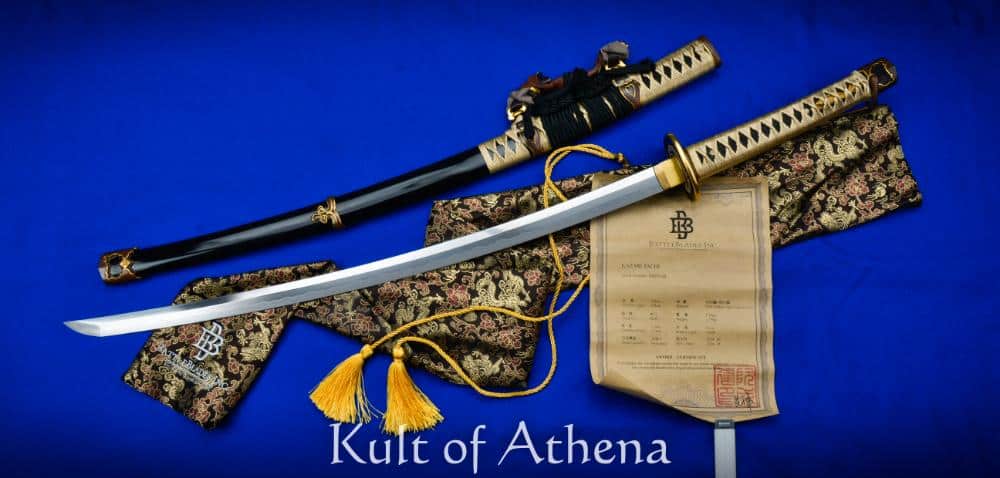


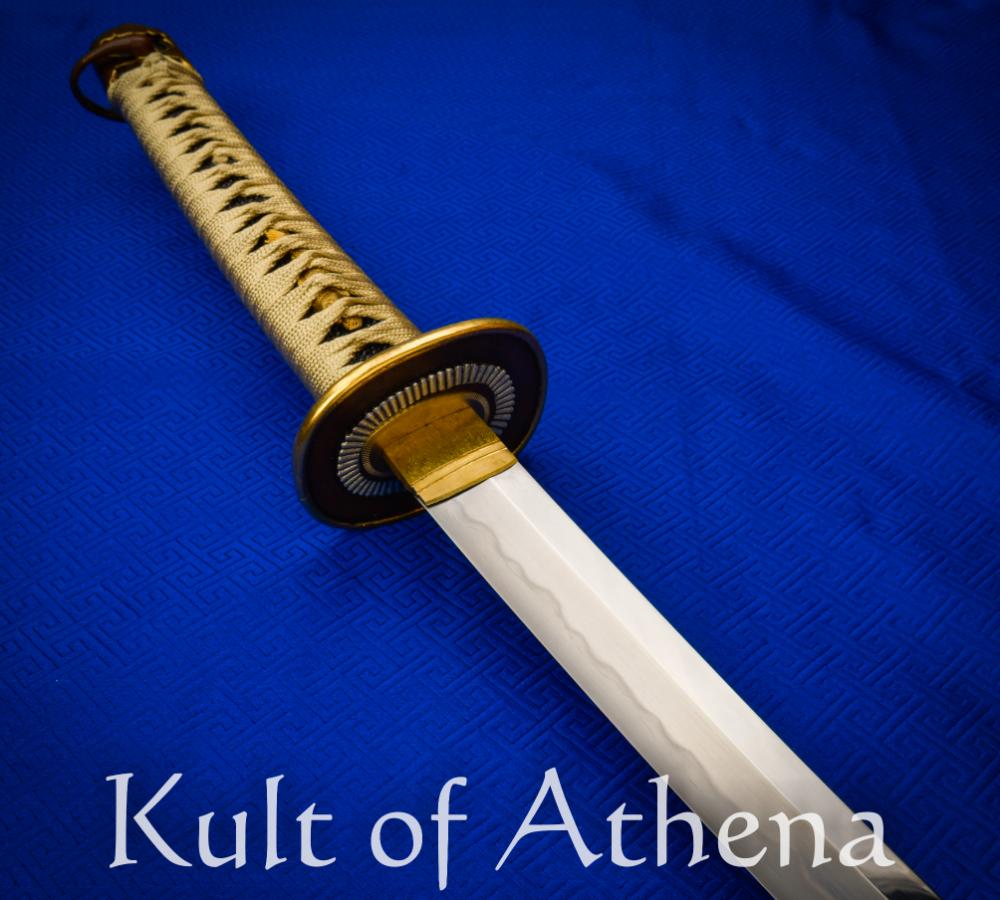
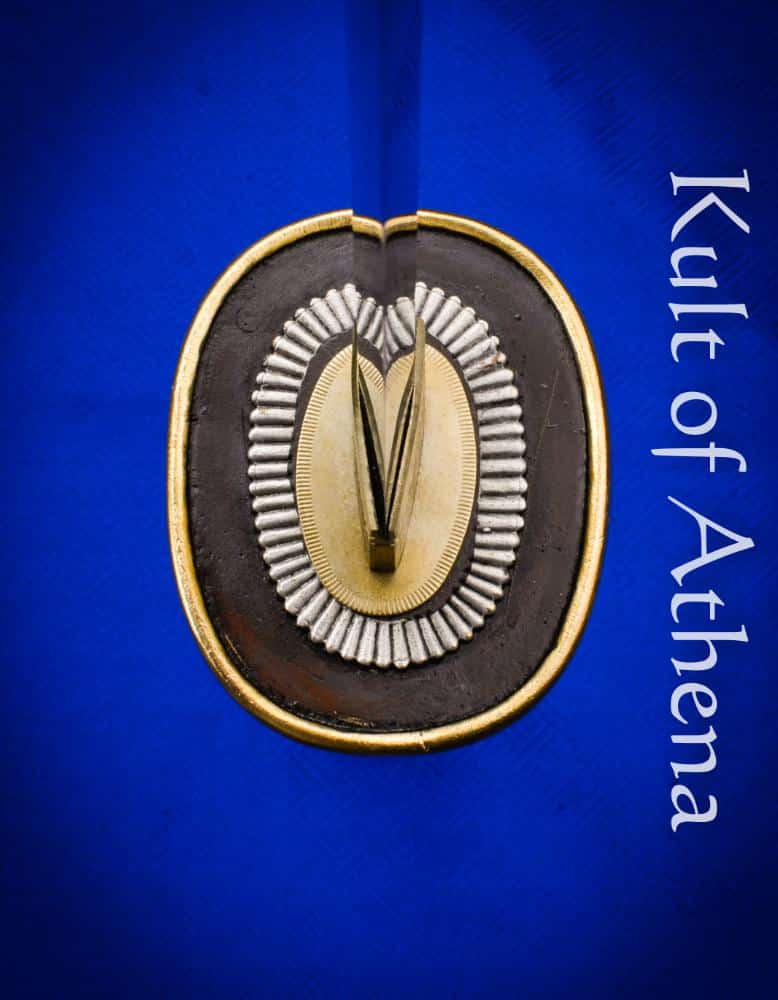
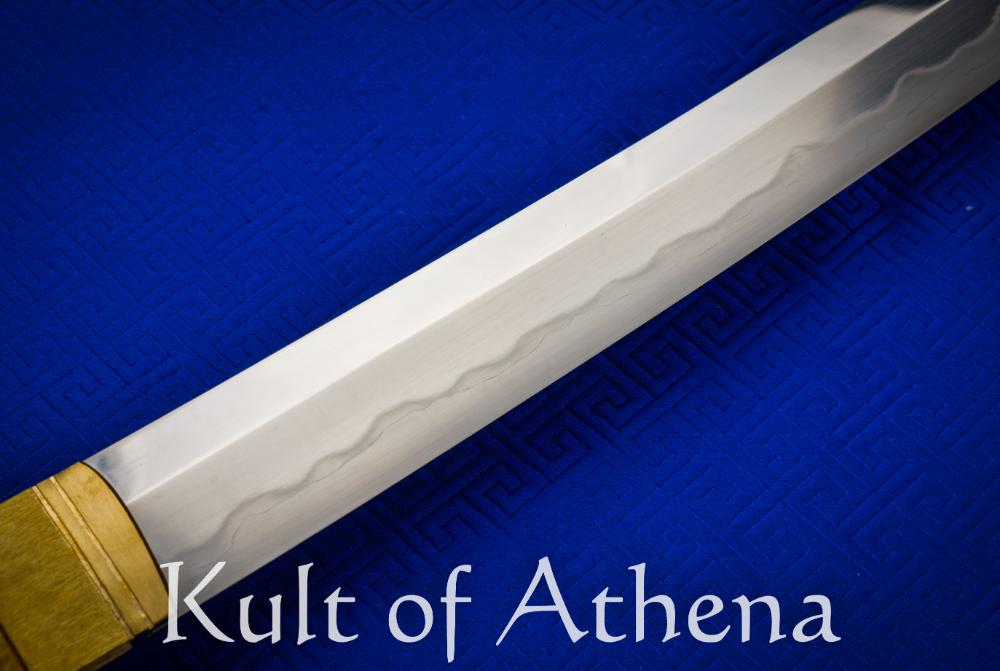
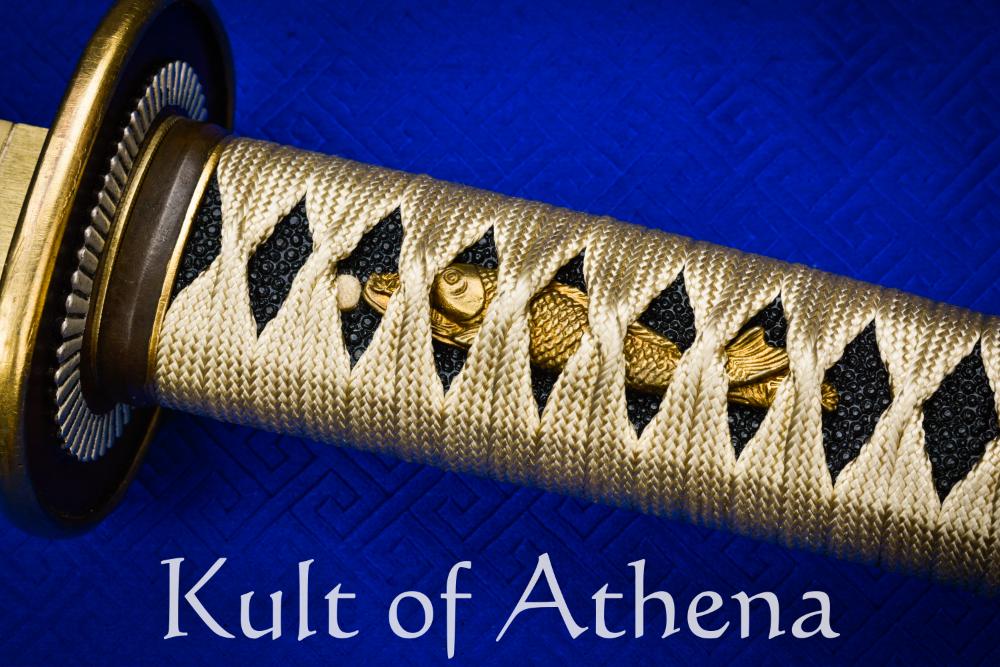
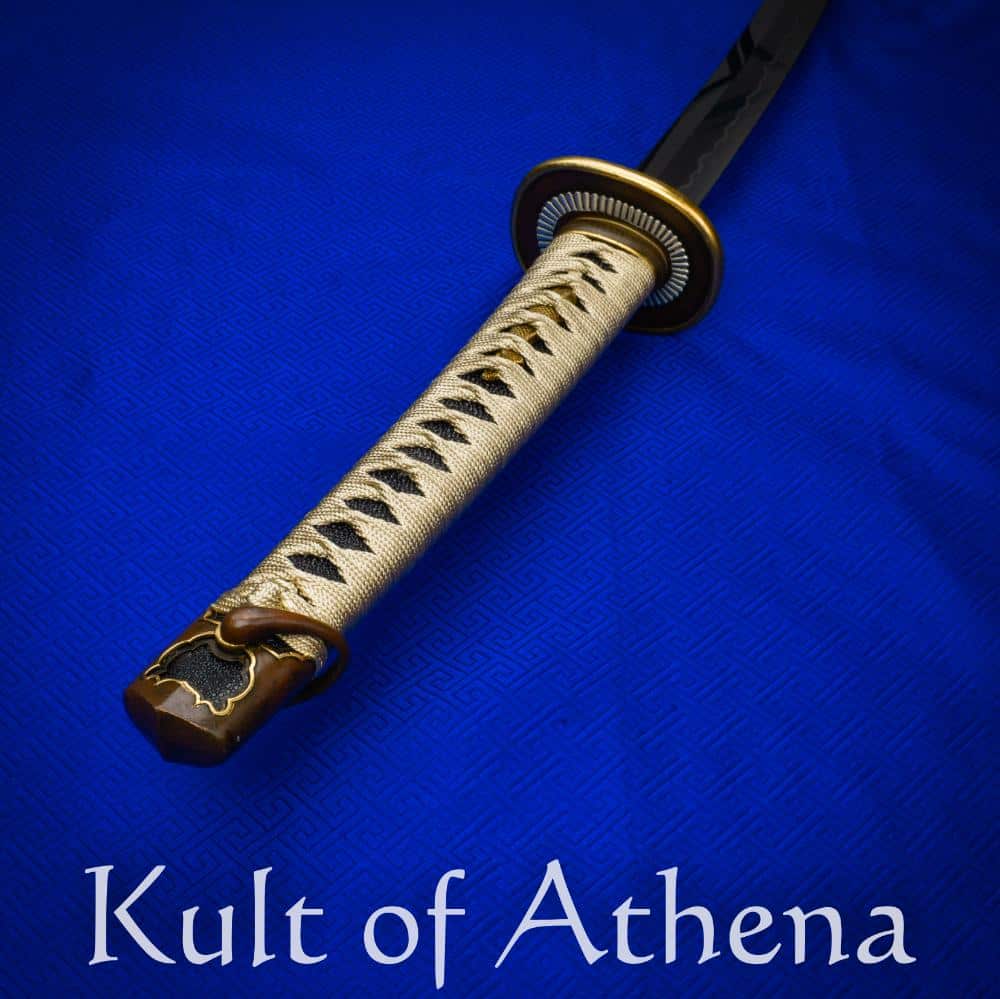





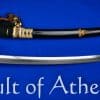
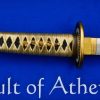


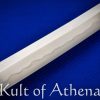


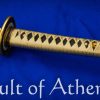
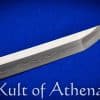

Reviews
There are no reviews yet.